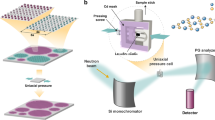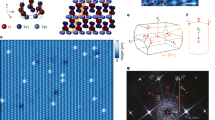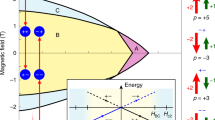Abstract
Superconductivity involving topological Dirac electrons has recently been proposed as a platform between concepts in high-energy and condensed-matter physics. It has been predicted that supersymmetry and Majorana fermions, both of which remain elusive in particle physics, may be realized through emergent particles in these particular superconducting systems. Using artificially fabricated topological-insulator–superconductor heterostructures, we present direct spectroscopic evidence for the existence of Cooper pairing in a weakly interacting half Dirac gas. Our studies reveal that two dimensional topological superconductivity in a helical Dirac gas is distinctly different from that in an ordinary two-dimensional superconductor in terms of the spin degrees of freedom of electrons. We further show that the pairing of Dirac electrons can be suppressed by time-reversal symmetry-breaking impurities, thereby removing the distinction. Our demonstration and momentum-space imaging of Cooper pairing in a half-Dirac-gas two-dimensional topological superconductor serve as a critically important platform for future testing of fundamental physics predictions such as emergent supersymmetry and topological quantum criticality.
This is a preview of subscription content, access via your institution
Access options
Subscribe to this journal
Receive 12 print issues and online access
$209.00 per year
only $17.42 per issue
Buy this article
- Purchase on Springer Link
- Instant access to full article PDF
Prices may be subject to local taxes which are calculated during checkout





Similar content being viewed by others
References
Hasan, M. Z. & Kane, C. L. Topological insulators. Rev. Mod. Phys. 82, 3045–3067 (2010).
Qi, X-L. & Zhang, S-C. Topological insulators and superconductors. Rev. Mod. Phys. 83, 1057–1110 (2011).
Wray, L. A. et al. Observation of topological order in a superconducting doped topological insulator. Nature Phys. 6, 855–859 (2010).
Grover, T., Sheng, D. N. & Vishwanath, A. Emergent space-time supersymmetry at the boundary of a topological phase. Science 344, 280–283 (2014).
Nandkishore, R., Levitov, L. S. & Chubukov, A. V. Chiral superconductivity from repulsive interactions in doped graphene. Nature Phys. 8, 158–163 (2012).
Fu, L. & Kane, C. L. Superconducting proximity effect and Majorana fermions at the surface of a topological insulator. Phys. Rev. Lett. 100, 096407 (2008).
Qi, X-L., Hughes, T. L., Raghu, S. & Zhang, S-C. Time-reversal-invariant topological superconductors and superfluids in two and three dimensions. Phys. Rev. Lett. 102, 187001 (2009).
Potter, A. C. & Lee, P. A. Engineering a p + ip superconductor: Comparison of topological insulator and Rashba spin–orbit-coupled materials. Phys. Rev. B 83, 184520 (2011).
Sau, J. D. et al. A generic new platform for topological quantum computation using semiconductor heterostructures. Phys. Rev. Lett. 104, 040502 (2010).
Hosur, P. et al. Majorana modes at the ends of superconductor vortices in doped topological insulators. Phys. Rev. Lett. 107, 097001 (2011).
Hor, Y. S. et al. Superconductivity in CuxBi2Se3 and its implications for pairing in the undoped topological insulator. Phys. Rev. Lett. 104, 057001 (2010).
Sasaki, S. et al. Topological superconductivity in CuxBi2Se3 . Phys. Rev. Lett. 107, 217001 (2011).
Zhang, D. et al. Superconducting proximity effect and possible evidence for Pearl vortices in a candidate topological insulator. Phys. Rev. B 84, 165120 (2011).
Koren, G. et al. Proximity-induced superconductivity in topological Bi2Te2Se and Bi2Se3 films: Robust zero-energy bound state possibly due to Majorana fermions. Phys. Rev. B 84, 224521 (2011).
Sacépé, B. et al. Gate-tuned normal and superconducting transport at the surface of a topological insulator. Nature Commun. 2, 575 (2011).
Qu, F. et al. Strong superconducting proximity effect in Pb–Bi2Te3 hybrid structures. Sci. Rep. 2, 339 (2012).
Cho, S. et al. Symmetry protected Josephson supercurrents in three-dimensional topological insulators. Nature Commun. 4, 1689 (2013).
Williams, J. R. et al. Unconventional Josephson effect in hybrid superconductor–topological insulator devices. Phys. Rev. Lett. 109, 056803 (2012).
Xu, J-P. et al. Artificial topological superconductor by the proximity effect. Phys. Rev. Lett. 112, 217001 (2014).
Mourik, V. et al. Signatures of Majorana fermions in hybrid superconductor–semiconductor nanowire devices. Science 336, 1003–1007 (2012).
Liu, J. et al. Zero-bias peaks in the tunneling conductance of spin–orbit-coupled superconducting wires with and without Majorana end-states. Phys. Rev. Lett. 109, 267002 (2012).
Roy, D., Bondyopadhaya, N. & Tewari, S. Topologically trivial zero-bias conductance peak in semiconductor Majorana wires from boundary effects. Phys. Rev. B 88, 020502(R) (2013).
Churchill, H. O. H. et al. Superconductor-nanowire devices from tunneling to the multichannel regime: Zero-bias oscillations and magnetoconductance crossover. Phys. Rev. B 87, 241401(R) (2013).
Lee, E. J. H. et al. Spin-resolved Andreev levels and parity crossings in hybrid superconductor–semiconductor nanostructures. Nature Nanotech. 9, 79–84 (2014).
Xu, S.-Y. et al. Hedgehog spin texture and Berry’s phase tuning in a magnetic topological insulator. Nature Phys. 8, 616–622 (2012).
Okazaki, K. et al. Octet-line node structure of superconducting order parameter in KFe2As2 . Science 337, 1314–1317 (2012).
Zhang, Y. et al. Crossover of the three-dimensional topological insulator Bi2Se3 to the two-dimensional limit. Nature Phys. 6, 584–588 (2010).
Neupane, M. et al. Observation of quantum-tunneling modulated spin texture in ultrathin topological insulator Bi2Se3 Films. Nature Commun. 5, 4841 (2014).
Blonder, G., Tinkham, M. & Klapwijk, T. Transition from metallic to tunneling regimes in superconducting microconstrictions: Excess current, charge imbalance, and supercurrent conversion. Phys. Rev. B 25, 4515–4532 (1982).
Wang, E. et al. Fully gapped topological surface states in Bi2Se3 films induced by a d-wave high-temperature superconductor. Nature Phys. 9, 621–625 (2013).
Xu, S-Y. et al. Fermi-level electronic structure of a topological-insulator/cuprate-superconductor based heterostructure in the superconducting proximity effect regime. Phys. Rev. B 90, 085128 (2014).
Yilmaz, T. et al. Absence of a proximity effect in a topological insulator on a cuprate superconductor: Bi2Se3/Bi2Sr2CaCu2O8 . Phys. Rev. Lett. 113, 067003 (2014).
Iwaya, K. et al. Electronic state of NbSe2 investigated by STM/STS. Physica B 329–333, 1598–1599 (2003).
Sánchez-Barriga, J. et al. Photoemission of Bi2Se3 with circularly polarized light: Probe of spin polarization or means for spin manipulation? Phys. Rev. X 4, 011046 (2014).
Hasan, M. Z. Topological Insulators: A New State of Quantum Matter presentation at Nobel Symposium on New Forms of Matterhttp://www.fysik.su.se/~ardonne/nobel/ns156-program.pdf (2014).
Acknowledgements
The work at Princeton and Princeton-led synchrotron-based ARPES measurements is supported by US DOE DE-FG-02-05ER46200. MBE growth of Bi2Se3/NbSe2 samples at Penn State was supported by ARO through ARO-MURI (W911NF-12-1-0461). The point-contact measurements were supported by US DOE DE- FG02-08ER4653 (Q.L.). C.F. and M.J.G. are supported by the ONR under grant N00014-11-1-0728 and N00014-14-1-0123 and B.D. and M.J.G. are supported by the AFOSR under grant FA9550-10-1-0459. Initial materials work was supported by MRSEC Program Grant DMR-0819860. M.J.G. is supported by NSF CAREER Award ECCS 13-51871. F.C.C. acknowledges the support provided by MOST-Taiwan under project number NSC-102-2119-M-002-004. We gratefully acknowledge E. Rienks for assistance at the BESSY facility. We also thank J. Denlinger, S-k. Mo, A. Fedorov, and M. Hashimoto for beamline support at the beamlines 4.0.3, 10.0.1, 12.0.1 at the ALS, and the beamline 5–4 at the SSRL, respectively.
Author information
Authors and Affiliations
Contributions
S-Y.X., N.A., I.B., C.L., M.N., and G.B. conducted the ARPES experiments with the assistance from M.Z.H.; A.R. and N.S. performed the Bi2Se3 MBE growth; S-H.H., R.S., and F.C. prepared the NbSe2 single crystalline samples; W.D. and Q.L. conducted the point-contact Andreev-reflection transport measurements; C.F., B.D., and M.J.G. performed theoretical calculations. M.Z.H. was responsible for the conception, overall direction, planning and integration among the research units.
Corresponding author
Ethics declarations
Competing interests
The authors declare no competing financial interests.
Supplementary information
Supplementary Information
Supplementary Information (PDF 6869 kb)
Rights and permissions
About this article
Cite this article
Xu, SY., Alidoust, N., Belopolski, I. et al. Momentum-space imaging of Cooper pairing in a half-Dirac-gas topological superconductor. Nature Phys 10, 943–950 (2014). https://doi.org/10.1038/nphys3139
Received:
Accepted:
Published:
Issue Date:
DOI: https://doi.org/10.1038/nphys3139
This article is cited by
-
Hosohedral nodal-line superconductivity in hexagonal ABC Dirac semimetals
Communications Physics (2024)
-
Crossover from Ising- to Rashba-type superconductivity in epitaxial Bi2Se3/monolayer NbSe2 heterostructures
Nature Materials (2022)
-
Creating Majorana modes from segmented Fermi surface
Nature Communications (2021)
-
Observation of topological superconductivity in a stoichiometric transition metal dichalcogenide 2M-WS2
Nature Communications (2021)
-
Detecting and distinguishing Majorana zero modes with the scanning tunnelling microscope
Nature Reviews Physics (2021)



